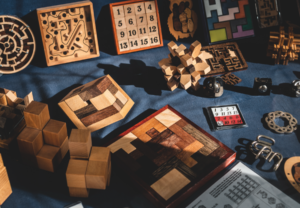Have you ever wanted to design you own mini-escape room experience? The DIY of escape rooms?

Maybe you’re a dungeon master and you want your players to go through an “escape room” dungeon. Maybe it’s your parents anniversary and you want to celebrate their romance with some love themed puzzles! Whatever escape room you want to design you’re in luck.
We’ve got some tips to help you build a fun, fantastic, and immersive experience.
Sharpen your pencils and open your mind to the wonders of puzzles.
Let’s get cracking.
Tip 1: Design a Theme and Build a Story
One of the best parts about escape rooms? The story!
Before you can create a story you’ve got to pick a theme. A theme is a message that your player will take away from the story. Themes help create further immersion and can help support an escape room goal (we’ll touch base on “goals” a bit further down on this article).
Once you have a theme you can pick your story. Constructing a narrative can seem complicated but it’s fairly easy. First, think about the overall feeling of the story. Is it cute, cuddly, colorful? Or is it dark, dreary, dangerous? Once you know what type of story you want to present you can flush out the narrative.
A narrative can be almost anything! It just has to account for a series of related events.
Perhaps there’s a magical land inhabited by rainbow bears, it’s almost the King Bear’s birthday and the bears are about to celebrate! Or, maybe an elite exploration crew is hunting down a mysterious signal in space.
Your story should be short and sweet. Think elevator pitch; thirty seconds, a key point or two, explaining the main concept.
The story will ground the experience and provide support for your escape room goal, the conflict of the story.
Tip 2: Establish an Escape Room Goal
The idea of an escape room? DUN DUN DUN…to escape!
Recently, escape rooms have been migrating from just escaping a room to requiring players to complete a goal in order to “escape”, to win.
Your goal shouldn’t be too overcomplicated. Think about something small but BIG enough to feel monumental.
Let’s look at our rainbow bears, for example. We’ll expand on the narrative and include a conflict.
The rainbow bears are going to celebrate King Bear’s birthday but they don’t have party supplies. Riddle Bear does, but Riddle bear locked away all the supplies. (Not cool Riddle Bear!) In order to get the supplies the rainbow bears must work together to unlock all supplies and create an amazing celebration for the King.
The goal is simple: collect the supplies.
Now, let’s think about puzzles.
Tip 3: Puzzles Puzzles Puzzles
Puzzles make the escape room world go round. For a mini escape room you won’t need many puzzles, anywhere from 3-8 will do.
There are many types of puzzles:
- Logic
- Word
- Math
- Sudoku
- And many more
How do you design a puzzle?
The first step to designing a puzzle is determining what the puzzle is doing. Does your escape room have physical locks, where players need to enter in a code? Or are you doing a paper and pen escape room, where an answer is determined from the puzzle but not entered into anything.
Then you need to know how your puzzles relate to each other. Will every puzzle be individual, meaning they don’t need any information from any other puzzles to be solved? Or do you need to solve one puzzle to be able to solve another?
Next, think about how you can incorporate your story into your puzzle design. You want the two things to be connected, as the narrative drives the immersive experience!
Once you have a general idea of your escape room you can begin making your puzzles.
Remember, designing puzzles can be hard! Google is your friend.
Tip 4: Play Test
Before you release your escape room to your friends or family, gather a few people who you don’t mind testing your puzzles.
Play testing will help you figure out what works and what doesn’t. Are your puzzles too hard? Too easy? (If you want them to be a certain difficulty this is important). Are your puzzles incomplete, do they contain incorrect information? Can they be solved?
Take notes to reference later!
Tip 4: Go Back to the Drawing Board
Yep you heard me right! You’ve gotta edit your puzzles.
Once you’ve edited and confirmed your puzzles are where you want them then get out there and let them be played!
The most important tip: have fun with it!
It’s not required to follow these tips to build a successful escape room. We’ve found that each time we build an escape room we’re doing something different, expanding on our previous knowledge and building a better experience.
We also suggest playing more puzzles! Playing puzzles will help you with your own ideas, and gain a better understanding of puzzle mechanics.
We hope these tips will help you when you design your escape room.
Good luck!
P.S. Want a taste of a mini escape room? Play out free Sasquatch On Site Online Game.

